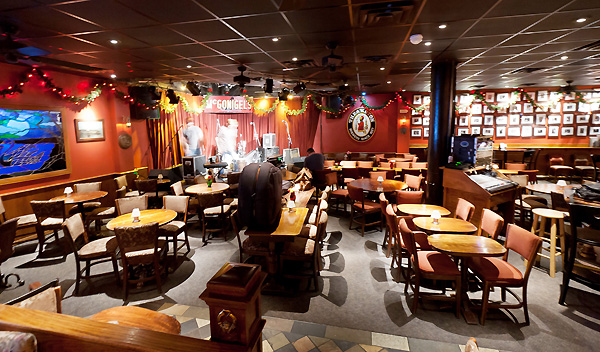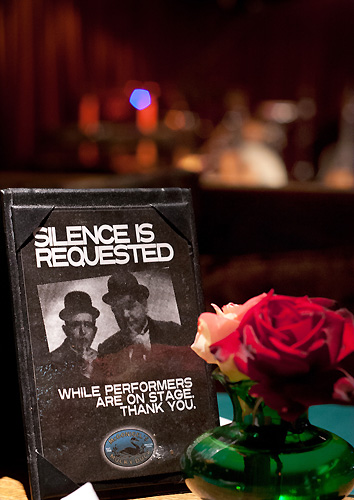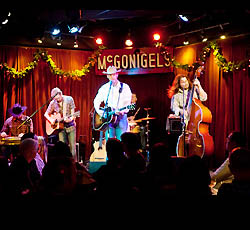McGonigels Mucky Duck is one of those venues that bands, engineers and fans love. An Irish-style pub in downtown Houston, it’s stage is noted in the folk, jazz, Americana and World Music spheres and has played host to the likes of Joe Ely, Shake Russell, Radney Foster, Kinky Friedman, James McMurtry, Druha Trava, Sarah Jarosz, The Magpies, Iris Dement, Michelle Shocked, Leon Redbone, and hundreds of others.
The official capacity is 140, which in my opinion, would be very packed and uncomfortable. They sell out the 100 or so table seats very fast for most shows, and the remaining tickets are for standing room only. As the website eloquently puts it, “If another chair would fit it would already be there. Sorry, but you can’t bring your own chair.”
The crowd is respectful. To help those who may be visiting for the first time, there are placards on each table reminding people to be quiet, and to silence cell phones. This is one of the best things about the Mucky Duck. They respect the artists. It’s the very definition of a listening room.
The place is not without drawbacks though, and here, I’ll outline some of those shortcomings and discuss ways that visiting engineers can work around them in order to deliver high-caliber sound reinforcement.
Dialed In
Saying the stage is small is being somewhat generous – I’ve seen bigger drum risers. It’s located in a corner, which is both a blessing, in the form of a little extra real estate, and a curse, because the drums will always be too loud.

Heavy theatrical drapery around the perimeter of the stage helps quiet reflected stage wash but does little to dampen the natural volume of the drums. The low ceiling doesn’t help either.
There is no house engineer, and management knows precious little except how to get the background music on. Bands are expected to bring their own mix engineer, and that person is usually the sound tech as well. The job is either easy or difficult, depending on the condition the previous engineer/tech left it in.
Luckily the level of talent booked here means that the system is usually zeroed out, and the stands and cables are neatly put away. Almost everyone leaves it a little better than they found it, which is also my philosophy – I don’t want the next guy to work any harder than he has to.

Both house and monitor systems use EAW loudspeakers, with four SM159z wedges on four separate mixes derived from front of house. Each mix has a 15-band EQ inline. With only 15 bands on the monitor sends, precise feedback taming will not happen. I bring a few XLR “wyes” in order to split the important inputs into two separate channels.
Using different channel strips – one EQ’d for the mains and one for monitors – allows much finer control over the house mix versus the monitor mix.
Main loudspeakers are FR159z, one each hung on the wall stage left and stage right, and two more toward the rear of the room providing fill. There are no subwoofers. And, there’s also no time-alignment on the front or rear loudspeakers, and no processor available to do so.
I solve this problem by bringing in a QSC DSP-4 digital processor, which I insert and use to set a 9-millisecond delay on the front loudspeakers.
When using a house system to supplement the stage volume, instead of overpowering it, delaying the mains to arrive in time with the band is the way to go, at least in my view. It helps the PA “disappear” and leaves the impression that the band is making all the noise.
I also set a 21-millisecond delay on the rear loudspeakers. With each of them a different distance from the front, I choose a delay time that splits the difference.
The downside of this is minimal because the improvement is quite dramatic, a huge benefit, and no one notices that the rear fills arrive a few milliseconds apart.
The 2-input by 2-output DSP-4 works out great – there aren’t all that many compact DSP units that can be controlled with a laptop available at a reasonable price point on the used gear market. I also like that it’s small enough to fit in my briefcase and uses standard XLR inputs and outputs. (In fact, I like it so much that I own two.)















